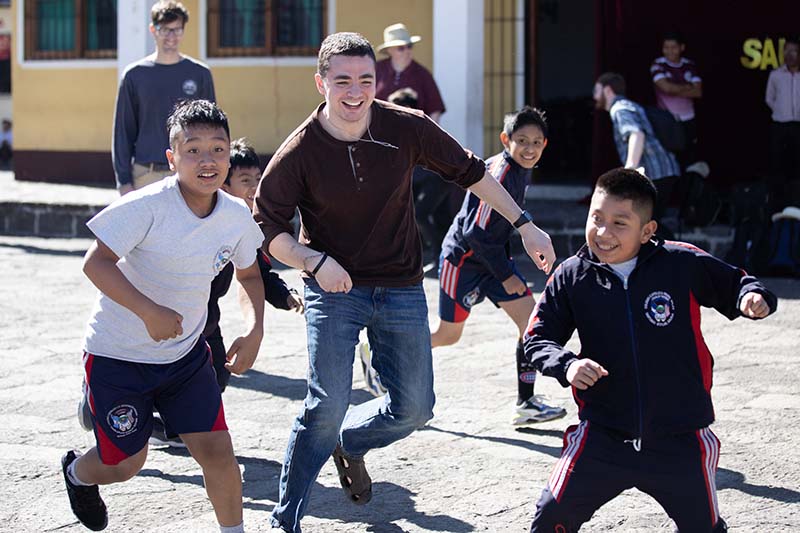Central American Martyrs Pilgrimage & Retreat
Thursday, April 25, 2024

Eighteen seminarians gathered around Fr. Jim Schimelpfening, SM, who works in the Spiritual Formation Office at Saint Meinrad and oversees several of the seminary’s retreats. After a day of traveling from the concrete jungle of Guatemala City to the literal jungle of Satiago Atitlán, it was the official start of the Central American Martyrs Pilgrimage and Retreat.
Fr. Jim opened by telling the seminarians that pilgrimages and retreats are about surprises and to be open to surprises from God and themselves. There were many surprises and impactful moments along the way.
The Central American Martyrs Pilgrimage and Retreat is a 10-day trip for the Second Configuration seminarians to Santiago Atitlán, Guatemala, where Blessed Stanley Rother was martyred, and Antigua. The trip includes an immersion into the story of Hermano Pedro, a 17th century Franciscan saint from Antigua. As the pilgrimage began, Fr. Jim told the seminarians that they will learn to be shepherds, to smell like the sheep.
“We believe that these experiences are important because of the witness and deep pastoral commitment of these two men,” says Fr. Jim “In a particular way, Blessed Rother because he was an American missionary and a priest of the Archdiocese of Oklahoma City, who gave his life for his flock. He was the ‘shepherd who didn’t run.’”
Among the trip highlights were:
- Attending Mass in Santiago Atitlán’s local church, St. James the Apostle Church, with the native Tzutuhil people. Mass was held in Spanish and the Tzutuhil language and the group experienced firsthand the universality of the Catholic Church. After Mass, the parishioners gathered in a courtyard to socialize, or went to the Adoration Chapel to pray. They were excited to meet and talk with the seminarians and the seminarians witnessed the faith, devotion, and the importance of community for the locals.
- Meeting a family that has two children with Down syndrome in San Juan. The family is one of several who make up the Artesanía Hermanos Down, an artisan shop that sells Guatemalan crafts, handmade by mothers of children with Down syndrome. The proceeds from their sales help pay for their children’s medical care.
The family held a reception for the seminarians where they met Wendy and Luis, who have Down syndrome. Luis is also blind and suffers from neurological disorders. The father of the family told the seminarians that Luis cannot see them, but he can feel their energy when they touch him. The father carried his son around to each seminarian and they held his hand, embraced him, and prayed for him.
- Hearing firsthand accounts of who Blessed Stanley Rother was and about a massacre that occurred in Santiago Atitlán on December 2, 1990. The group gathered in the room where Blessed Stanley was martyred to hear from Don Andrés, who was a boy when Blessed Stanley came to Guatemala on a diocesan mission. They became close friends and Blessed Stanley had a huge impact on his life.
Later that day, the group traveled to Parque de la Paz, the Park of Peace where the massacre took place. Felipe Coché Pablo was a boy when he peacefully marched with his unarmed family and neighbors. The Guatemalan military opened fire killing 13, including three children. Since then, the Guatemalan military has been banned from Santiago. These firsthand accounts made the people and events more real for the seminarians deepening the understanding of the experience.
- Going to the Catholic school founded by Blessed Stanley, Colegio Católica Padre Aplás. Last spring, Saint Meinrad held a fundraiser to buy a new tuba, desks, and computers for the school. In the fall, a fundraiser was held to provide penicil pouches, made by Artesanía Hermanos Down, filled with school supplies for each child.
The children assembled in the courtyard and the band played music featuring the new tuba. When the children returned to the classrooms, the seminarians distributed the pencil pouches and candy. The children also had an extended recess where they played soccer and other games with the seminarians. It was an uplifting end to the group’s time in Santiago.
- Volunteering with special needs individuals at the Virgen del Socorro, one of the social works inspired by the life and service of Hermano Pedro. Hermano Pedro was devoted to social work, serving the most vulnerable and needy.
The residents of Virgen del Socorro do not receive many visitors and the seminarians were encouraged to talk to them, hold their hands, rub their backs. Some seminarians helped feed residents their lunch or took them outside for a walk.
The pilgrimage and retreat taught the seminarians what it means to be a missionary through the examples of Blessed Stanley Rother and Hermano Pedro’s lives.
“Without these experiences there is a risk of staying in the head with one’s nose in the books. With this experience, the ‘classroom’ becomes life, prayer, pastoral care, theology that is praxis,” explains Fr. Jim. “These retreats and pilgrimages are essential to the formation of future priests in the Church. They give flesh to what is learned in other ways in the seminary and help the seminarians become shepherds who don’t run, just like Jesus the Good Shepherd who went all the way to the cross.”